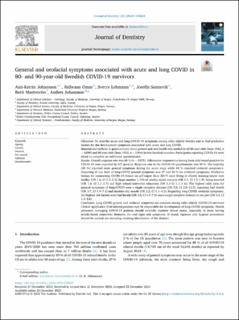| dc.contributor.author | Johansson, Gerd Ann-Katrin Janmyr | |
| dc.contributor.author | Omar, Ridwaan | |
| dc.contributor.author | Lehmann, Sverre | |
| dc.contributor.author | Sannevik, Josefin | |
| dc.contributor.author | Mastrovito, Berit | |
| dc.contributor.author | Johansson, Anders Arne | |
| dc.date.accessioned | 2024-03-22T12:55:06Z | |
| dc.date.available | 2024-03-22T12:55:06Z | |
| dc.date.created | 2024-01-09T10:12:02Z | |
| dc.date.issued | 2023 | |
| dc.identifier.issn | 0300-5712 | |
| dc.identifier.uri | https://hdl.handle.net/11250/3123858 | |
| dc.description.abstract | Objectives
To describe acute and long COVID-19 symptoms among older elderly Swedes and to find predictive factors for the development symptoms associated with acute and long COVID.
Material and methods
A questionnaire about general and oral health was mailed to all 80-year-olds (born 1942, n = 6299) and 90-year-olds (born 1932, n = 1904) in two Swedish counties. Participants reporting COVID-19 were asked to complete an additional questionnaire.
Results
Overall response rate was 66 % (n = 5375). Affirmative responses to having been sick/tested positive for COVID-19 were reported by 577 persons. Response rate to the COVID-19 questionnaire was 49 %. The majority (88 %) reported some general symptoms during the acute stage while 44 % reported orofacial symptom/s. Reporting of any form of long-COVID general symptoms was 37 and 35 % for orofacial symptoms. Predictive factors for contracting COVID-19 (based on self-report from 2017) were living in elderly housing/senior care facility (OR 1.6, CI 1.0–2.3), large number (>10) of weekly social contacts (OR 1.5, CI 1.3–1.9), being married (OR 1.4, CI 1.1–1.7) and high school/university education (OR 1.3 CI 1.1–1–6). The highest odds ratio for general symptoms of long-COVID were a single complete denture (OR 5.0, CI 2.0–12.3), reporting bad breath (OR 3.7, CI 1.9–7.2) and daytime dry mouth (OR 2.2, CI 1.1–4.2). Regarding long-COVID orofacial symptoms, the highest risk factors were bad breath (OR 3.8, CI 1.9–7.5) and a single complete denture in one jaw (OR 3.4, CI 1.2–9.8).
Conclusion
Long-COVID general and orofacial symptoms are common among older elderly COVID-19 survivors
Clinical significance
Oral microorganisms may be responsible for development of long-COVID symptoms. Health personnel managing COVID-19 patients should carefully examine dental status, especially in those having acrylic-based removable dentures, for oral signs and symptoms. If found, rigorous oral hygiene procedures should be carried out including cleaning/disinfection of the denture. | en_US |
| dc.language.iso | eng | en_US |
| dc.publisher | Elsevier | en_US |
| dc.rights | Navngivelse 4.0 Internasjonal | * |
| dc.rights.uri | http://creativecommons.org/licenses/by/4.0/deed.no | * |
| dc.title | General and orofacial symptoms associated with acute and long COVID in 80- and 90-year-old Swedish COVID-19 survivors | en_US |
| dc.type | Journal article | en_US |
| dc.type | Peer reviewed | en_US |
| dc.description.version | publishedVersion | en_US |
| dc.rights.holder | Copyright 2023 The Author(s) | en_US |
| dc.source.articlenumber | 104824 | en_US |
| cristin.ispublished | true | |
| cristin.fulltext | original | |
| cristin.qualitycode | 2 | |
| dc.identifier.doi | 10.1016/j.jdent.2023.104824 | |
| dc.identifier.cristin | 2222872 | |
| dc.source.journal | Journal of Dentistry | en_US |
| dc.identifier.citation | Journal of Dentistry. 2023, 141, 104824. | en_US |
| dc.source.volume | 141 | en_US |

